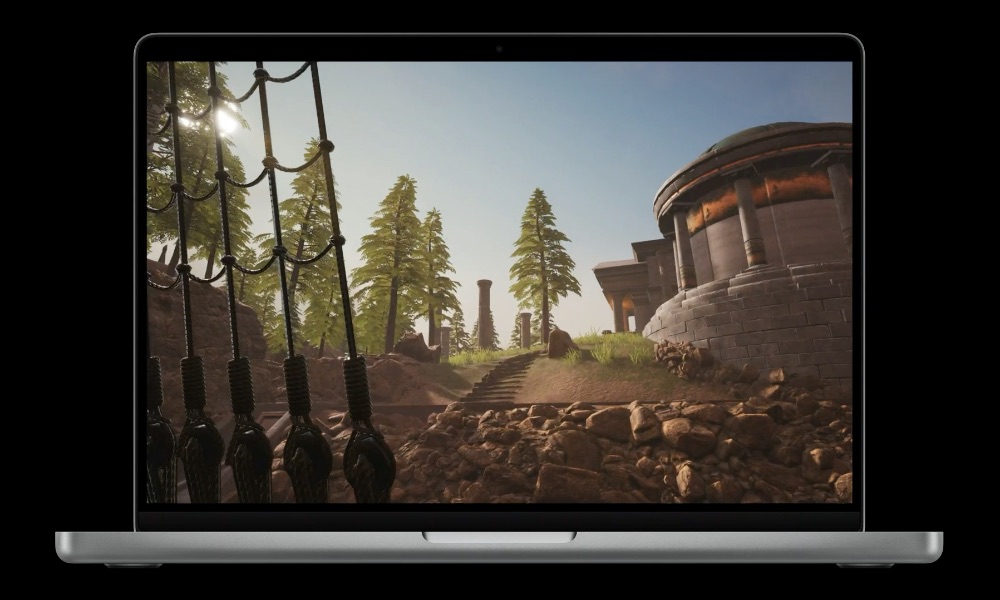‘Myst’ Gets the Full Apple Silicon Treatment

Toggle Dark Mode
Nearly four years ago, developer Cyan reimagined the legendary Myst for Apple Silicon, and now it’s giving the same treatment to the entire franchise.
While Apple Silicon delivered enough groundbreaking performance improvements over prior Intel chips to turn the Mac into a gaming powerhouse, many game developers still haven’t embraced it. However, it seems only fitting that Myst, one of the first games to be released exclusively for the Mac over thirty years ago, has been reintroduced for the Apple silicon generation.
The new version of Myst brought native support for Apple’s M-series chips, but also Metal 2.1 and AMD FidelityFX Super Resolution, giving it a 50 percent performance boost, even when running at 4K resolution. However, the developers went a big step further, rebuilding it from the ground up to take advantage of improved modeling, textures, and dynamic lighting effects to create new art, new sound, re-imagined interactions, and even the ability to randomize the puzzles for an extra challenge. They built it using the Unreal Engine to provide “fresh takes on the visuals in every area of the game.”
Now, the developers are doing the same for the rest of the series, with new versions of Myst: Masterpiece Edition, Riven: The Sequel to Myst, and Myst III: Exile. A month ago, they also added the Age of Rime to the classic Myst.
In addition to optimizing the games to run natively on Apple Silicon, the updates also offer game controller support, remastered scores, enhanced sounds, and better save game support.
The transition is somewhat apropos, considering that Myst debuted in Apple’s pre-Intel days. In 1993, Apple was transitioning the Mac from the Motorola 68k chips to the PowerPC architecture that would form the foundation for the early OS X era following Steve Jobs’ return to the company. The Intel transition was still over a decade away at that point.
Myst launched on September 30, 1993, and remained Mac-exclusive for the first six months. During that time, it sold a staggering 200,000 copies — a significant number considering Apple was barely selling two million Macs a year back then. Following its March 2024 PC launch, it racked up sales of six million copies, making it the best-selling game in history for nearly a decade until it was overtaken by The Sims in 2002.
The game was developed by Rand and Robyn Miller of Cyan Worlds. It was revolutionary for being one of the first CD-ROM games, taking advantage of the optical disc format that offered 700 MB of storage at a time when the largest consumer hard drives topped out at 300 MB. The game was also credited with helping to drive the adoption of CD-ROM drives in Macs and PCs, as it was the only way you could play the game.
The Miller brothers were huge Mac fans who were inspired to create Myst by the Macintosh Hypercard development program. The original Myst offered a pre-rendered world of extremely high-quality graphics by the standards of the day, and it ushered in a new era of CD-ROM (and later DVD-ROM) games.
In 2000, the company released realMyst, a full-motion graphics version of the game that also included the Rime age, but the team at Cyan wanted to ensure that the reimagined 1993 Myst stayed as true as possible to the original, and it has followed the same playbook with the rest of the series. These aren’t about creating new worlds but rather expanding them to include those things that always should have been there, such as clouds in the sky instead of a plain gray background, better lighting effects, and more realistic movement when manipulating objects in the puzzles.
The reimagined games are available on the Mac App Store, with Myst: Masterpiece Edition and Riven: The Sequel to Myst priced at $6 each, and Myst III: Exile going for $15. The classic Myst is $35 if you haven’t already purchased it, but those who have can get the Age of Rime as a free update.









